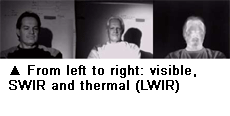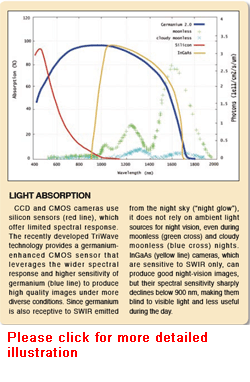There are, literally, hundreds of camera choices for providing security during daytime. At night, these cameras and the security they provide are, however, severely compromised. Luckily, technological breakthroughs have made seeing at night easier and nocturnal vision clearer.
There are, literally, hundreds of camera choices for providing security during daytime. At night, these cameras and the security they provide are, however, severely compromised. Luckily, technological breakthroughs have made seeing at night easier and nocturnal vision clearer.
Due to certain inherent limitations of image sensors used in traditional daytime cameras, night vision comes with a whole new set of requirements. Today's solutions require using supplemental illumination or novel yet sometimes costly camera technologies such as thermal cameras. These solutions have merit, but all suffer from performance limitations that ultimately lead to a lack of coverage and security. Such limitations include:
* Expensive illumination installation and maintenance
* Limited field of view
* Limited visibility
* Limited range/monitoring of large security perimeters
* Inability to identify (only detect)
* Inability to read vehicle license plates and other markings
* High cost
Corporations and system integrators do the best they can with their security budgets. Unfortunately, in many cases, this means choosing to compromise external perimeter surveillance and security coverage because of high costs and low night-vision performance.
Video surveillance is, instead, focused on the interior of a facility where there is 24-hour lighting, and outdoor locations that are close to the facility or can be easily illuminated.

Night Glow to the Rescue
A revolutionary solution with TriWave CMOS image sensor technology is being developed. This solution involves sensing a natural light source which previously, due to image sensor cost, has never been effectively used as a night-vision solution for security use.
The source of light in question is created by the interaction of the earth's atmosphere with the solar winds. It starts with the solar winds agitating hydrogen and oxygen ions 90 kilometers high in the earth's atmosphere, causing these ions to release their energy in the form of light.
This naturally occurring but relatively unknown phenomenon results in a considerable amount of light or “night glow” that comes from the entire night sky.
The only problem is that this light is emitted in the short-wave infrared (SWIR) band with wavelengths of 1,200 to 1,800 nm (visible light is in the 400 to 700 nm range). The SWIR light is undetectable by human eyes and also to the many millions of installed security cameras around the world because of their standard, silicon-based CMOS or CCD image sensors, which are unable to sense this valuable, night-time light source.
The atmospheric SWIR light is a perpetual source of natural illumination but requires specialized image sensors to detect it. This is where the TriWave technology enters. Security and surveillance cameras that are TriWave-enabled can sense this SWIR band (from 1 to 2 μm) and have significant advantages over cameras that use visible and near infrared (NIR) wavelengths for night imaging.
The night sky actually emits substantially more light in the SWIR band than in the visible one, but capturing or sensing this light source is not easy. SWIR image sensors have been manufactured with a hybrid chip-to-chip assembly, consisting of a sensor array made from complex semiconductor materials, interfaced to a CMOS-based electronic signal readout circuit.
Every photo detector or pixel on the sensing array needs its own individual bump bond to a circuit on the readout chip, which adds to the complexity and cost of these image sensors, making them very expensive and less attractive to commercial security camera makers.
A Low-Cost, High-Performing Approach
Using a single CMOS chip, TriWave enables security and surveillance cameras to see in harsh, zero-light conditions, surpassing the capabilities of even the most sensitive low-light cameras on the market. The breakthrough is to significantly enhance the wavelength response of a standard CMOS image sensor through the addition of germanium to the CMOS process.
Germanium is an element that is sensitive to SWIR, and its longer wavelength sensitivities are due to its smaller band gap properties. Unlike the very expensive, multichip, complex semiconductor image sensors, TriWave's silicon-based process produces hundreds of visible-to-SWIR imaging chips on a single CMOS wafer, manufactured with high uniformity, reliability and low cost.
Additional advantages of the CMOS process are that it allows for small pixel sizes and higher resolution imagers, resulting in smaller/lower optics, camera system size, weight and cost. Another advantage of TriWave is that it is sensitive across three bands of the electromagnetic spectrum — visible, NIR and SWIR. Therefore, TriWave enabled cameras can function both day and at night, eliminating the need for separate cameras.

Pitted Against Other Technologies
Another imaging technology that is starting to be deployed more is an enhanced silicon CCD called an electron multiplying CCD (EMCCD). Cameras using these imagers have significantly better low-light performance. Yet, they still have the same light spectrum limitations as traditional silicon-based imagers, and cannot take advantage of the SWIR night glow.
Additionally, EMCCD cameras are deployed at a significant premium to standard CCD cameras. They allow for an incremental increase in performance, but still have significant limitations when compared to a SWIR-based camera.
Because of the limitations of silicon based cameras, long-wave infrared (LWIR), or thermal cameras as they are commonly called, are starting to be considered for night-time security applications.
However, these systems rely on sensing the emitted heat that objects transmit in contrast to their surroundings. Sensitivity is measured in millikelvin differences in temperature a camera can detect. These cameras are manufactured using proprietary foundries and licensed designs that were originally developed for the military and today range in price from US$20,000 to $30,000 per camera for VGA resolution.
Thermal cameras do have some benefits. They can detect through fog and smoke, do not require any light source, and can be used inside a building. As such, one application for this technology is for firefighters to use handheld devices to maneuver through fire or smoke.
For night-time security, however, there are a number of significant drawbacks that should be considered. The first is that sensing heat emitted from a person, versus reflected light, yields a completely different image. Significant image detail, such as facial features required for identification, is not possible. Second, objects such as vehicle license plates or ID badges cannot be read for forensic purposes.
The last significant drawback is that thermal imagers cannot see through glass. As such, traditional glass enclosures for camera systems cannot be used, and expensive optics need to be developed.